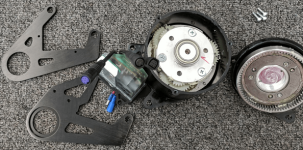Hubs are still a fantastic option, but it seems like we're close to reaching the limits of how much better they can get without the cost approaching that of a mid drive. A big selling point is still less moving parts = less things to break, and low cost. hub motors aren't going anywhere.
From a engineering point of view direct drive hub motors are pure sex. What other vehicle can you get away with having what amounts to a solid state drive train? That has to be somebody's holy grail somewhere.
The fact that they are cheap and mundane and heavy are all good things. Yeah sure they can be improved and I really want to see that, but I am happy right now for what they are. But when you try to tell some guy that spent a extra 900 dollars on his bike to save 2 pounds of weight that he should slap a 14 pound motor to his bicycle.. yeah I can see why that would be unattractive to some people.
Are you referring to the "first gen" geared hub motors like Cute or Mac? or the newer Bafang GXXX hubs? I haven't heard much long term test info on the Bafangs. Is it the durability or noise or performance that's disappointing?
The Achilles heal of geared hub motors is cooling. You have a small motor spinning inside of a sealed steel case. There is nowhere for that heat to go. This limits the amount of torque they can produce... torque is amps and amps is heat. For example: The Bafang 31x motors are awesome, but can't really handle continuous speed up past 25mph by themselves due to the thermal limitations. Hill climbing they can provide a lot of boost, but you are going to need to pedal and keep the speed up on big hills or you are going to hit their thermal limits after a few minutes.
When you take a 9c-style direct drive hub motor and throw statorade oil cooling at it then you boost the torque potential by a easy 50%. This means that right now a 300 dollar high efficiency 1500w DD hub motor with statorade and a 20 inch wheel will out climb any other type of ebike out there. People talk about needing mid-drives to climb hills, but I doubt most common mid-drives people use on bicycles will be able to match that.
Now entering fantasy land...
If you can solve the cooling issues with geared hub motors then there wouldn't really be any reason to use anything else for 90% of people out there, I am guessing. If you can get a similar 50% boost then a little 250w class motor like the Bafang suddenly turns into a 400w class motor, and peak torque goes from 45nm to almost 70nm.
A bigger high-efficiency motor like the Em3ev-sold 'Improved' Mac motor or Grin's GMAC motor would go from something like 80nm peak torque to 120nm and be rated at 1500 watts continuous.
So you end up with a bike that would be able to tackle most hills pretty easily and provide a moped-like experience for people who want that... yet be still almost 100% pedal-friendly.


